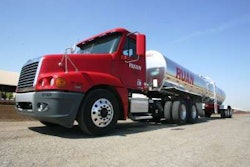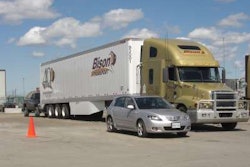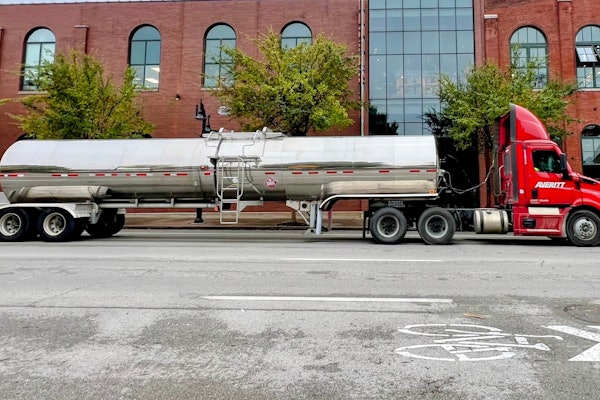 The National Highway Traffic Safety Administration estimates that shorter stops will save 227 lives a year.
The National Highway Traffic Safety Administration estimates that shorter stops will save 227 lives a year.
It’s possible that tractors built to meet a new braking standard would be able to use the same specs as today’s equipment, but at a minimum, better friction materials would be required. That seems to be the consensus of some leading suppliers as the truck building industry looks down the road at a mandate for a 30 percent reduction in minimum stopping distance at 60 mph as required by a recent National Highway Traffic Safety Administration regulation.
In most combinations of vehicle configuration and gross vehicle weight rating, NHTSA will require that a loaded tractor-trailer stop within 250 feet as opposed to 355 feet today. Full implementation is expected by August 2013, though most configurations are subject to it by August 2011.
NHTSA initially had proposed a reduction in the range of 20 to 30 percent to be settled during the rulemaking process. Compliance falls strictly on the vehicle supplier, not the fleet, and the regulation applies only to new equipment; there is no retrofit requirement. (For more on the specifics of the NHTSA rule, including what axle/GVWR combinations must comply when, see Journal, CCJ, August 2009, or go to www.regulations.gov and search NHTSA-2009-0083.)
Several parties, including the Truck Manufacturers Association and the Heavy Duty Manufacturers Association’s Heavy Duty Brake Manufacturers Council, have filed petitions for reconsideration on several technical elements of the rule, but it doesn’t appear that any significant party is objecting to the rule in broad terms.
Staying the course?
While a standard on-highway spec today – 15- x 4-inch steer axle/16.5- x 7-inch drive axle drum brake package – might meet NHTSA’s performance standard, that will need to be confirmed, Mac Whittemore, regional manager for ArvinMeritor Commercial Vehicle Systems, told attendees in a session at last month’s Technology & Maintenance Council. It’s fairly clear, however, that moving a step up to a 16- x 5-inch steer/16.5- x 8 5/8-inch drive package not only would meet the standard comfortably but also provide some benefits in terms of longer life, he said.
The next step would be to install air disc brakes on the steer axle with 16.5- x 7- or 8 5/8-inch drums on the drive axle, Whittemore said, adding that the premium solution would be air disc brakes all around. Each step gains stopping capability, braking consistency and the potential for longer life, but also increased purchase cost and changes in maintenance practices, Whittemore said.
Vince Lindley, manager of national account fleet service for Volvo Group North America, agreed that a 15- x 4-inch steer axle/16.5- x 7-inch drive axle drum brake package might prove to meet the NHTSA standard, but there would need to be lining and drum changes.
Moreover, lining life could be reduced, and lining choices could be limited, Lindley told the TMC audience. In addition to higher performance – at a higher cost – bigger brakes would be heavier, unless the fleet chose to adopt air disc brakes on some or all wheel ends, he said.
Plenty of warning
The new stopping distance rule certainly was no quick thing; NHTSA issued the proposed rule almost four years ago, and that was years after interested parties expected them to do so. With that much lead time, brake system suppliers have been positioning their product offerings and research and development accordingly.
“Our R&D efforts have been targeted to helping our customers achieve the new stopping distances with economical drum brake solutions,” says Wolfgang Winzer, president of Webb Wheel Products.
For most vehicle operators, upgrading to larger and/or wider S-cam drum brake sizes is a viable alternative to air disc brakes, Webb Wheel says, noting that drum brakes are not less expensive to spec but are easier to service. In addition to current brake drums, Webb’s Vortex brake drum technology introduced in 2007 offers benefits in weight and durability, the company says, adding that improved heat dissipation in the Vortex maximizes lining life and reduces lifecycle costs.
ArvinMeritor says it has worked for more than three years to ensure that its line of Meritor Q Plus drum brakes would meet the NHTSA standards. The Q Plus drum brake currently is undergoing the final phases of implementation testing to meet the new requirement, the company says.
“It’s a real benefit that truck operators are able to meet their stopping needs and the new federal stopping distance requirements without having to make significant changes to their drum brake specifications or service practices,” says Joe Plomin, vice president, Truck, ArvinMeritor.
Opening for discs?
But the higher cost aside, air disc brakes have advantages, including lower weight, which is becoming increasingly important as emissions regulations drive up equipment weight and shippers push for increased payload. And improved performance could yield significant savings in reduced accident frequency and severity.
One objection to air disc brakes is that technicians’ training on and familiarity with drum brakes is far greater. That’s a legitimate concern, though it could be temporary. There’s also some notion among truck owners that air disc brakes are somehow experimental.
But resistance to air disc brakes appears to be weakening. Bendix Spicer Foundation Brake recently reported that its air disc brakes have experienced a 30 percent year-over-year growth in units sold in each of the past three years and that an estimated 150,000 Bendix air disc brakes are now in use on North American highways on equipment sold by all six of the major truck OEMs.
“Our air disc brakes have a track record of more than 20 years,” says Jon Morrison, president of Meritor Wabco Vehicle Control Systems. Morrison notes that the disc versus drum issue doesn’t necessarily have to be a strictly either/or proposition. Meritor Wabco offers air disc brakes as an all-wheel package, or front air disc brakes combined with rear drum brakes and trailer air disc brakes. A disc-drum hybrid solution could offer a fleet operation the opportunity to gain some experience with air disc brakes at a lower cost than an all-wheel package.
Bendix says that its line of foundation brakes – which include drum, air disc and combinations of the two – already can meet the new government mandate and that it offers application-specific solutions that provide improved safety and reduced cost per mile.
“The final rule is an important step toward balancing stopping performance between the many vehicle types that share our roadways, and we look forward to working with our OEM customers in this vital effort,” says Walter Frankiewicz, president of Bendix Spicer Foundation Brake.
One point that all brake suppliers emphasize is that there will be more than one way to achieve NHTSA’s stopping distance mandate. Fleet owners will be able to find braking configurations that make sense for their operations without having to adopt specific technologies required by a government agency.











